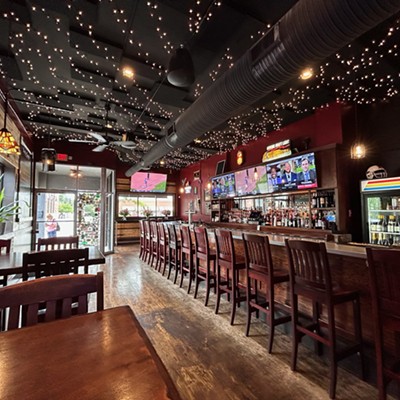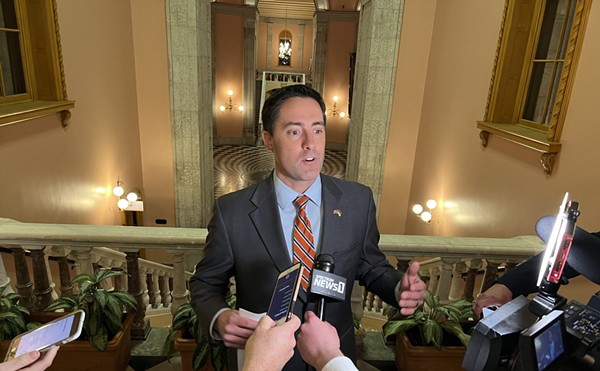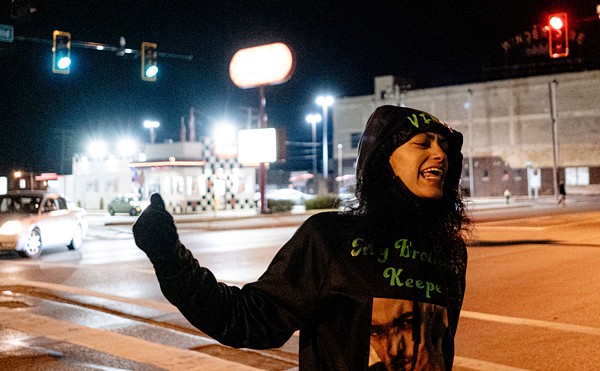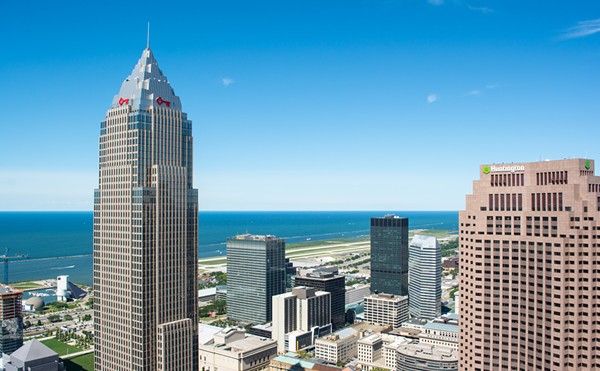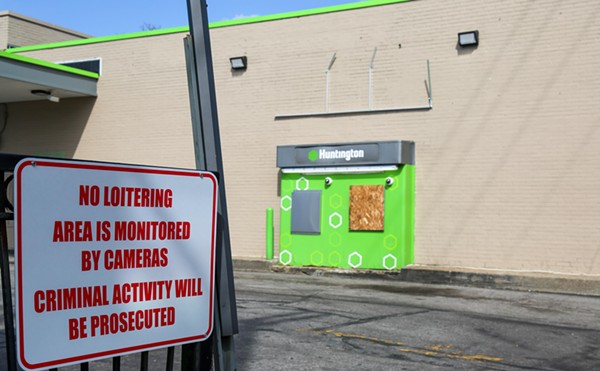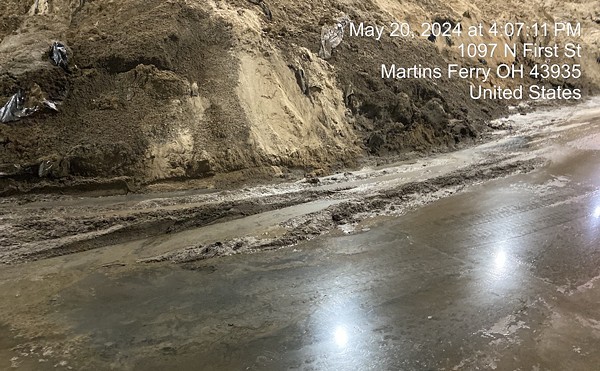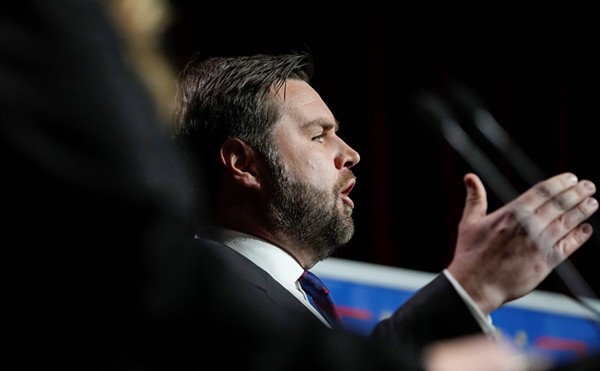Just a stone's throw from the Euclid-Cleveland border, this '60s-era hilltop development seemed far away from the problems of the city.
Chris Gruber was just a boy back then. His father moved to Euclid after losing both legs in the battle of Iwo Jima. Despite his handicap, he continued to work 30 more years as a metalsmith.
Now Gruber is an old man himself, the kind with Nixonian jowls and a genuine love for the word "motherfucker." He serves as his hometown's councilman.
But Indian Hills is no longer a made it destination. Now it's the black neighborhood.
It seemed to happen so fast. Factories boarded up, grocery stores closed. The once-bustling Euclid Square Mall was reduced to an empty husk -- the kind of place that would be a good site to shoot a zombie movie.
When whites started following their jobs out of town, blacks from East Cleveland and Collinwood started buying up their homes. Many whites who hadn't already left fled to higher ground in communities like Mentor and Willoughby.
Today, the trend continues. Gruber's shiny black Cadillac hovers down a street dotted with "For Sale" signs.
"That's white people," Gruber says, pointing to one sign. "That's white people," he repeats, pointing to the sign in a neighbor's yard. Other stops on the tour include foreclosed and abandoned houses, and Gruber's next-door neighbor, a black man recently out of prison for dealing crack.
For many white residents in Euclid, even those who don't consider themselves racist, their dying town's problems have a color.
"As soon as one black moved in, the whole street went," says Frank Znidar, a 52-year-old machinist whose car has been vandalized three times. "There were 'For Sale' signs all down the street."
The new arrivals spread north like a weather pattern, crossing the Interstate and shifting toward the lake. Now, when someone uses Lake Shore Boulevard as a geographical reference -- as in "south of the Boulevard" or "north of the Boulevard" -- it has little to do with geography.
But while people have long spoken of race in hushed tones, the issue is now being splashed across newspaper front pages. Aroused by resistance to a black church's zoning request, federal investigators swooped into town.
They crunched some numbers and came to the conclusion that Euclid's system of drawing council wards was suppressing the black vote.
Now, the U.S. government is suing Euclid to force it to change its election system, accusing the city of institutionalized racism -- a charge that infuriates Mayor Bill Cervenik.
"They should be ashamed of themselves," Cervenik says of the feds. "They fly in from Washington, D.C., and make those allegations . . . I'm very impressed and proud at the way our community has accepted diversity."
"It's full o' fuckin' niggers," spits an old man with a face like a swollen prune and tattoos like faded chalk drawings. "They come in like fuckin' ants."
The dim lighting of Paddy's Pour Haus barely illuminates a warbly cast of characters lined up at the whiskey-soaked bar. These are the boys of "the Patch," an old public-housing development originally built to house hundreds of workers who arrived during the boom years of World War II.
Euclid was a proud city back then, says the old man. In fact, it was known as "the fastest-growing city in the United States." Its rail lines made it ideal for manufacturing, and the industrial corridor along Euclid Avenue pumped money and jobs into the city. GM built planes for the military. Chase Brass and Copper built cartridges for ammunition. And the federal government teamed up with Thompson Products (later TRW) to build a massive aircraft-parts plant on what was once 120 acres of vineyards.
Back then, Euclid's new arrivals went to school on their G.I. Bill benefits, started families, and went to work in the factories. At dawn you'd see lines of them walking down Euclid Avenue, lunch pails and thermoses in hand.
Euclid was a boomtown. There were four major supermarkets. Euclid Square Mall, built in 1977, had two major department stores and teemed with shoppers.
But the good times didn't last. TRW closed up shop in 1985. GM boarded up its Fisher Body plant in 1994. Chase Brass was sold to a Korean company, which shut the doors in 1998.
Deprived of consumers, the stores started closing. Groceries boarded up. Euclid Square Mall lost Kaufmann's, and then, one by one, the rest of its tenants closed their rattling steel shutters, until there was nothing left but a climate-controlled ghost town.
America's fastest-growing city is now one of America's fastest-shrinking. Euclid has lost nearly one-third of its population, hovering at just over 50,000 people.
And "For Sale" signs keep sprouting.
On Miller Avenue, a stretch of pavement as long as an airport runway is dotted with monopoly houses that one by one are going up for sale.
When Theresa Sparks, a 40-year-old account manager, bought her petite two-story colonial eight years ago, Miller was a proud street. Many of her neighbors had inherited their homes from their parents, and they cared for their houses and yards like cherished heirlooms.
Sparks moved here from Collinwood so that her son, Bill, then 12, could go to a better school.
But now there's a realtor's sign planted among the flowers in her front yard. Her neighbor across the street has one to match. So does a house a few doors down.
The problem, as Sparks sees it, is that the city followed her here to Miller. As the street's blue-collar lifers died off or left, urbanites -- many of them renters and rent-to-owners -- moved in.
Now, the once-proud homes are in various states of disarray. Lawns are overgrown. Siding is chipping off. Sparks' brand-new fence was recently spray-painted with graffiti. Cars speed down the street. Roving bands of teenagers hang out at the corner, smoking Black & Milds. There are fights. Cars are broken into. A house down the street was just robbed.
Sparks has held two open houses since she listed her home a month ago, but the few people who did come weren't interested for the money. She recently dropped her asking price $5,000, but even that might not be enough. Her neighbor has already gone $10,000 cheaper.
The old man at Paddy's, however, will never leave. Whiskey fuels his anger tonight.
His friend, a younger, skinnier guy named Gary, tries politely to steer the conversation away from race. "This really isn't the place to get into an intelligent conversation about --"
"It's the fuckin' truth!" the old man interrupts; his gravelly voice sounds like the undercarriage of a car scraping against the cement. "Tell 'em to come over to where we are: poor. I can't get no money from the government, fuckin' Section 8 . . ."
Just then, a black couple walks into the bar. A white guy at the end of the bar throws him a warning gesture.
The old man turns around to see the couple, then squares his eyes back toward the bar. "I ain't talkin' about this no more."
Zena Williams came to Miller Avenue for the same reason that Theresa Sparks wants to leave.
The 42-year-old mother of three teenage girls had had enough with the drama and drugs of her tired St. Clair Avenue neighborhood. She wanted her daughters to get a good education in a safe school.
"Crime?" Williams asks, puzzled, when told of her neighbors' gripes. She chuckles and shakes her head. They don't know what crime is.
Williams, a stamping-plant inspector, didn't receive any apple pies when she moved here a year and a half ago. Instead, on moving day, she heard a neighbor yell out his window, "We don't want no more niggers around here!"
Williams doesn't speak to her neighbors across the street or the ones next door. The "For Sale" signs in their front yards tell her all she needs to know. When she sees any of them, they nod and wave like guests in a hotel.
Williams can't blame them for wanting to leave. "They wanna live in a nicer neighborhood, with a nicer school system," she says.
Just the other day Williams walked outside her door to find a group of black kids beating up two white boys. She shooed them off. "Me being black, I wouldn't tolerate nobody jumping on my child like that," she says.
Maybe Williams will leave Miller Avenue someday, if the neighborhood really goes to hell. Blacks aren't that much different from whites in that respect: They each run in the same direction. One of Williams' friends just fled Maple Heights for Twinsburg.
Thirty years ago, East 193rd Street looked like Miller Avenue. Pearletha Taylor remembers it well. The former Cuyahoga County social worker moved here from Cleveland's East Side three decades ago. She was one of the first in a wave of middle-class blacks who came to the neighborhood, called Heritage Park, in the '70s. Back then, she says, "Everything was just gorgeous. Everyone's lawn was beautiful. It was quiet. The school system was excellent."
Now, "It's a mess. We have homes that have been vacant and empty for years, deteriorating." Several black families have already abandoned her street and the one next to it, says Taylor. The neighborhood's gotten so bad that one of the families actually escaped back to Cleveland.
Taylor recently spent more than $20,000 to build a sunroom on the back of her house. A wrought-iron patio set sits in her lush backyard. The neighbor behind her has a chain-link fence overgrown with weeds, and the siding is falling off the house. Across the street is a sprawling, decrepit complex of low-rise apartments, a haven for drug boys.
At one end of Taylor's street are the train tracks that separate her from Cleveland. Kids from the city used to crawl through a hole in the fence and come to Taylor's street to deal dope. After nine years of complaining, she finally got the city to fix the fence.
The pesky problem at the other end of her street is what brings Taylor to the Euclid City Council meeting tonight. She patiently waits her turn in line at the microphone, then walks up to the podium and looks at the council members with the face of a disappointed grade-school teacher.
She says she wants the city to force the "A-rab gas station" at the corner of Euclid and East 193rd to clean up its property.
"Did she just say that?" gasps a white woman sitting in the audience.
After the council meeting, Taylor's friend tells her she shouldn't have said "A-rab."
Taylor shrugs it off. It's the truth, she says. "We have so many problems here. We just want to live comfortable."
A 1979 study by the Urban League of Cleveland found that the Euclid Police Department was badly lacking in diversity.
At the time, the city was 7 percent black, and there were 106 cops on the force, all of them white.
Now, 27 years later, the city is more than 30 percent black. And it has one black cop.
Mayor Cervenik hopes to change that. The new batch of police applicants has many black faces, he says, and he hopes they "finish way high on the list." If only the Justice Department would give his city the chance, says Cervenik, it "will see that there is no real problem."
But many blacks don't share his rosy outlook.
"The issue with the election process is a tip of a much bigger iceberg going on in Euclid," says Stanley Miller, head of the Cleveland NAACP.
Miller says he's received numerous complaints from black residents in Euclid -- everything from police harassment to discrimination in the schools.
It's not that Euclid produces many more complaints than other inner-ring suburbs, says Miller. It's that Euclid seems to be in denial about the problem.
"I think they believe they can handle it themselves. The community's changing. People are losing control, and they don't want to do that."
Jerry Corbran is the face of the old Euclid. The towering white octogenarian chuckles when he hears people playing the race card. He's no racist; he just wants to live in a prosperous town again.
"Nobody likes to be called a racist," Corbran says from the small TV room of the two-story house he built here in 1960.
The decorations -- patterned lime-green curtains and brown shag carpet -- haven't changed. Neither have Corbran's views. He's been fighting low-income development in Euclid since the '70s.
He entered politics when the deteriorating projects of "the Patch" were being demolished and the city was mulling over plans to bring in another sprawling rental complex. Corbran mobilized a citizens group and letter-writing campaign against it, and won. In place of the low-income housing, sod was laid down and sand traps dug for a new municipal golf course.
Corbran's philosophy -- "You're not going to prosper unless you bring in people with more disposable income" -- made brutal economic sense. It also attracted the watchful eye of the U.S. Department of Housing and Urban Development, which in 1978 accused Euclid of not promoting fair housing for the poor and froze the city's block-grant money. Among HUD's concerns was that rent-subsidy recipients would be displaced after the city sold yet another housing project to a condo developer.
Then there was the black church. In 2003, Providence Baptist, a massive congregation from Cleveland's Mount Pleasant neighborhood, approached Euclid with a plan to build a sprawling new sanctuary on vacant land it had purchased just south of Euclid Avenue.
There would be seating for 2,100 and more than 100 new homes for its congregants. The only roadblock was getting the city to rezone the land.
The issue split the city council. Those against the proposal argued economics. Euclid should hold out for something more lucrative than a tax-exempt church, they said. Perhaps an industrial park, or a luxury development that would incorporate the area's lush trees, ravines, and wetlands into its design.
The church's plans, on the other hand, "would be like living next to a mall," says Council President Ed Gudenas.
The only problem with opponents' arguments was that the 68-acre tract had sat vacant for decades, with nary a nibble of interest from anyone but the church.
In the end, council voted 5-4 to approve the rezoning.
Then the ugliness started.
Corbran started a citizens group, the Euclid Awareness Committee, in an effort to get a referendum against the rezoning onto the ballot. Rumors spread that Providence would bring another slum to Euclid. Charges of racism abounded.
"You're so afraid of the fact that people are saying that you're racist," Law Director Brian Meister told council members during one meeting. "But you are."
He was promptly demoted.
In November 2004, voters killed the Providence project. Two weeks later, Mayor Cervenik used his executive power to overrule the vote. The Euclid Awareness Committee responded with another petition, this time to recall the mayor. They collected enough votes to put his job on the line in the May 2005 primary, but Cervenik narrowly survived.
Now there's nothing standing between Providence and its plans for the new church. But Corbran and his allies still think it's a mistake. Euclid needs to build homes like the ones in Avon Lake and Macedonia if it wants to compete for new upscale residents, he says.
"I'm a practicing Catholic, and it would be a terrible sin on my soul if I were to practice any kind of racial bias," Corbran says. "If a person has the money, let them come into the town."
Like it or not, Euclid is changing. One of the city's largest white churches, East Shore United Methodist, now has its first black pastor.
When the Reverend Gary Henderson came here five years ago, his family of three doubled the number of East Shore's black congregants.
Integration came in "baby steps," says Henderson, who grew up under segregation in Jackson, Mississippi. Now, when he looks out at the pews on Sundays, he sees blacks, Jamaicans, and Asians praying with white families.
Henderson counsels all colors in his office, which is warm and smells of incense. When people come to him, it's rarely because the blacks are moving onto their street, Henderson says. It's because they're 50 years old and jobless, and all they know how to do is stamp metal.
"This community lives with not just the specter, but the reality of death every day," says Henderson. "Everything in our community is changing, and the difficulty is that it's all changing at the same time."

